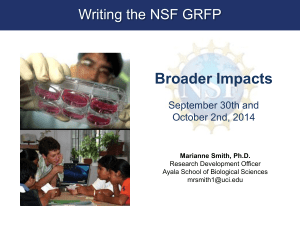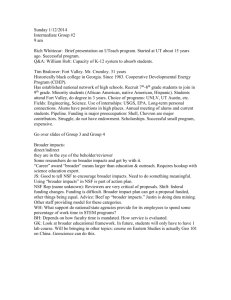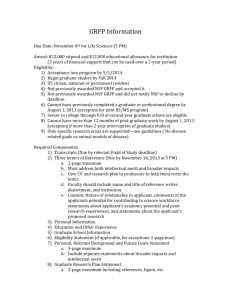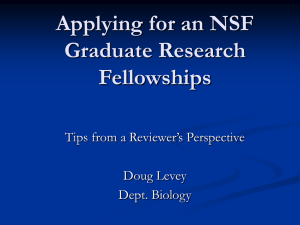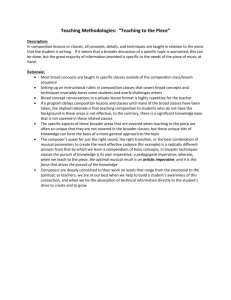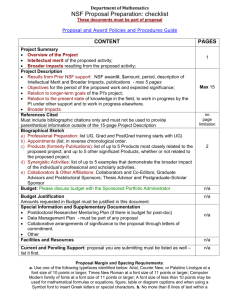Broader Impacts
advertisement
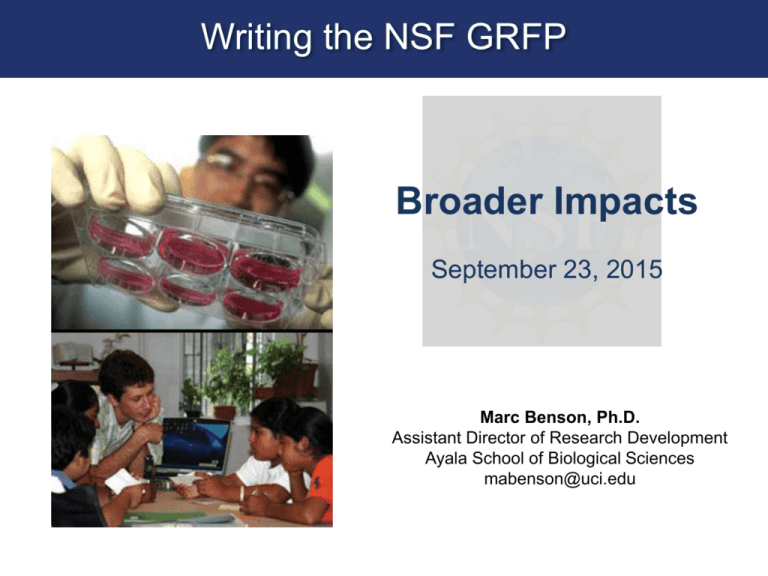
Writing the NSF GRFP Broader Impacts September 23, 2015 Marc Benson, Ph.D. Assistant Director of Research Development Ayala School of Biological Sciences mabenson@uci.edu NSF Application Review Process Each application will be reviewed independently in accordance with the NSF Merit Review Criteria using all available information in the completed application. Reviewers are instructed to address the two Merit Review Criteria as approved by the National Science Board - Intellectual Merit and Broader Impacts “Applicants must include separate statements on Intellectual Merit and Broader Impacts in their written statements in order to provide reviewers with the information necessary to evaluate the application with respect to both Criteria.” Reference Broader Impacts in: • Personal, Relevant Background and Future Goals Statement (3 pages) • Graduate Research Statement (2 pages) • 3 Letters of Reference NSF GRFP Review Criteria Intellectual Merit The IM criterion encompasses the potential to advance knowledge. Panelists evaluating GRFP applications may consider the following: the potential of the applicant to advance knowledge based on analysis of the complete application, including the personal statement, relevant background, future goals, graduate research statement, strength of the academic record, description of previous research experience or publication/presentations, and references. Broader Impacts The BI criterion encompasses the potential to benefit society and contribute to the achievement of specific, desired societal outcomes. Panelists may consider the following: the potential of the applicant for future broader impacts as indicated by personal experiences, professional experiences, educational experiences and future plans. NSF GRFP Review Criteria Broader Impacts Broader impacts may be accomplished through: 1. the research itself, 2. the activities that are directly related to specific research projects, or 3. activities that are supported by and complementary to the project. NSF values the advancement of scientific knowledge and activities that contribute to achievement of societally relevant outcomes, such as 1. full participation of women, persons with disabilities, and underrepresented minorities in science, technology, engineering, and mathematics (STEM); 2. improved STEM education and educator development at any level; 3. increased public scientific literacy and public engagement with science and technology; 4. improved well-being of individuals in society; 5. development of a diverse, globally competitive STEM workforce; 6. increased partnerships between academia, industry, and others; 7. improved national security; 8. increased economic competitiveness of the US; and 9. enhanced infrastructure for research and education. NSF Application Review Process What are the broader impacts of the proposed activity? • How well does the activity advance discovery and understanding while promoting teaching, training, and learning? • How well does the proposed activity broaden the participation of underrepresented groups (e.g., gender, ethnicity, disability, geographic, etc.)? • To what extent will it enhance the infrastructure for research and education, such as facilities, instrumentation, networks, and partnerships? • Will the results be disseminated broadly to enhance scientific and technological understanding? • What may be the benefits of the proposed activity to society? NSF Application Review Process Give Specific Details for your Broader Impacts’ Activities: • What do you plan to do? • Why do you want to do this activity? • How do you plan to accomplish your goal? • How will you know if you succeed? • What benefit could this Broader Impact activity accrue if the project is successful? Broader Impacts - Examples Advance discovery - promote teaching and learning • K-12, teachers, undergrads, grads, post-docs • Promote programs that will improve the transition of community college students to UCI Broaden participation of underrepresented groups • Education of underrepresented minorities and women • Partner with minority-serving institutions Enhance the infrastructure • Emphasize partnerships and collaborations Include broad dissemination • Partnership with museums and other similar institutions • Make data available in a timely manner Benefit society • Partner with Federal Agencies and/or private sector to integrate research into activities of national interest • Provide information for policy formulation by Federal, State or local agencies You can piggyback on outreach activities already occurring in your department and on campus Outreach Activities in Bio Sci Visit the Biological Sciences outreach page at http://www.bio.uci.edu/students/graduates/outreach/ • Bridges to Baccalaureate Program (NIH) helps minority community college students who are interested in a biomedical career transition to a four-year university. • Minority Biomedical Research Support Program (NIH) mentors minority undergraduate and graduate students to encourage and support them as they pursue doctoral degrees and biomedical careers. • Minority Access to Research Careers Program (NIH) seeks to increase the number of underrepresented minority researchers in biomedical research careers by supporting junior and senior URM students in their preparation for graduate training in the biomedical/behavioral sciences. • Undergraduate Research and Mentoring Program in the Biological Sciences (NSF) has an objective of preparing URM undergraduates to excel in PhD programs in biological research. • Minority Health and Health Disparities International Research Training Program (NIH) supports URM students interested in studying or conducting research abroad. • Minority Science Program Educational Outreach Activities The MSP maintains contact with numerous K-12 teachers in socio-economically diverse school systems. Graduate student visits to present a research talk or conduct an experiment or activity can be arranged. • Science Fair Initiative has helped thousands of K-12 students from three Southern California school districts prepare science fair projects. • Teacher Professional Development Program offers summer and Saturday workshops for science and math teachers at districts with a high proportion of minority students. • DECADE Competitive Edge Summer Research Program is a summer pre-entry program geared to incoming female and minority Ph.D. students who are underrepresented in their disciplines. Participants conduct research under the direct supervision and guidance of a UC Irvine faculty member. The program features workshops and seminars designed to familiarize participants with campus resources, foster professional development, and establish peer support networks. Center for the Neurobiology of Learning and Memory CNLM outreach programs • Become a Docent for CNLM’s school tour program • Educate students about the brain using hands-on exhibits • Gain teaching experience • Brain Awareness Week (BAW) • Visit local schools to educate students about the brain and brain health • Visit our website for more details www.cnlm.uci.edu Outreach Activities on Campus There are also campus-wide outreach programs at the Center for Educational Partnerships: www.cfep.uci.edu • COSMOS: California State Summer School for Mathematics & Science at www.cosmos.uci.edu • CAMP: California Alliance for Minority Participation in Science, Engineering and Mathematics at www.camp.uci.edu • UCI Rocket Science Tutors: http://www.rocketsciencetutors.com • TechTrek Science and Math Camp for Girls: partnership between AAUW and UC Irvine - http://www.aauw-techtrek.org/uci/ Work with a society or group on campus (e.g. minority associations) Expand an outreach program you were involved in as an undergraduate Talk with your advisor or “join” an outreach program that another graduate/undergraduate student is doing. Be creative - use of 21st-century media opportunities: • Write a blog (and document hits), upload a podcast, start a Twitter feed (and document followers), Tumblr, Pinterest, social media… Outreach Activities off Campus Get involved with local and regional organizations: • Aquarium of the Pacific • Discovery Science Center • Santa Ana Zoo • LA Natural History Museum • San Diego Zoo and Wild Animal Park • Orange Country Science and Engineering Fair • Orange County Science Education Association • Orange County Conservation Corp • Girls Inc. Putting Broader Impacts in your Application Personal, Relevant Background and Future Goals Statement • Describe any leadership roles you have held – does not have to be confined to the discipline that you have chosen to pursue • Describe any teaching, tutoring or mentoring roles • Describe general public education, K-12 outreach and/or community involvement • Describe international or collaborative experiences abroad • Describe any effort to fostering diversity on all levels (across disciplines, gender, race, economic status, geography, etc.) – do you have a personal experience? Putting Broader Impacts in your Application Personal, Relevant Background and Future Goals Statement • How did your research advance the field? • How did your research impact society? • How did your research promote international or interdisciplinary collaborations? • How was your research disseminated to the community? • Did you do research or presentations abroad? • How did your research have an impact on underrepresented minorities or promote women in science? Did you mentor/teach/tutor anybody? • Were you involved in broader impact programs at your University? • Did you have any leadership roles in your lab? Putting Broader Impacts in your Application BEFORE: My broad interests are in global environmental sustainability and education. I have spent time in a number of developing countries and during 2010 I volunteered in Guatemala for three weeks. I worked with an organization called Ecolibri, addressing community and environmental health. AFTER: I lived in Haiti during a significant portion of my childhood and spent time in a number of developing countries, experiences that have contributed toward my broad interests in global environmental sustainability and education. In 2010, I volunteered in Guatemala for three weeks working with an organization called Ecolibri that addresses community and environmental health in the Lake Atitlan area. The lake, which many locals rely on as a water source, is threatened by pollution from tourists and a growing population. I worked on a recycling and community cleanup project using plastic bottles stuffed with trash as building material for fences and inner house walls. In addition I helped and learned from the local environmental health and water manager, Carlos. One day as we worked to collect water samples and measure bacterial growth, in the space which serves as his office, laboratory, and meeting room, I asked Carlos what he perceives are the biggest challenges for his community. He didn’t think twice before responding, education. Volunteering in Guatemala gave me a glimpse of different life perspectives, a practical application of common laboratory techniques, as well as emphasizing the importance of community outreach and education. Putting Broader Impacts in your Application Graduate Research Plan Statement • How will your research advance the field? • How will your research impact society? • Will your research promote international or interdisciplinary collaborations? • Will you do research or presentations abroad? • How will your research be disseminated to the community? • How will your research have an impact on underrepresented minorities or promote women in science? Will you mentor, teach or tutor anybody? • Do you plan to be actively involved in the community? • Will you develop an outreach project that relates to your research project or field? • Will you creatively integrate research and education? • Will you or have you become involved in broader impact programs at your University? • Will you have any leadership roles in your lab? Putting Broader Impacts in your Application IN SUMMARY: • Be thorough – provide specific examples and evidence • Utilize existing resources • Be creative • Partner and collaborate

